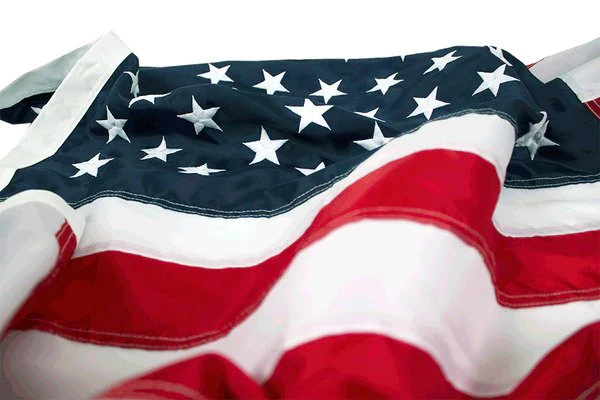The American flag is a revered symbol of the nation, embodying its history, ideals, and collective identity. When a flag becomes worn, torn, or otherwise unfit for display, it’s essential to retire it respectfully. Many people may find themselves with a flag tucked away in their basement, unsure of how to proceed with its disposal. Here’s a guide to help you honorably retire an American flag, ensuring its legacy is upheld even as it is laid to rest.

Why Proper Flag Disposal Matters
The American flag isn’t just a piece of cloth—it’s a powerful representation of the country’s values and the sacrifices made by those who defend it. Showing respect in its retirement honors not only its history but also the people it represents. Proper disposal isn’t simply a procedural step; it’s a gesture of gratitude, reflecting our commitment to respect the principles embodied by this national emblem.
Knowing When It’s Time to Retire a Flag
Retirement of an American flag should be considered when the flag becomes overly faded, frayed, torn, or permanently stained beyond cleaning or repair. Flags that are slightly worn can often still be displayed, but those that can no longer represent the country in a dignified manner deserve a respectful retirement.
Traditional Flag Disposal Methods
Several time-honored methods exist to retire the American flag with dignity. Among them, ceremonial burning is the most recognized, but there are also options like flag retirement ceremonies, community drop-off points, and even creative repurposing. Each approach ensures the flag’s respectful retirement, honoring its importance as a national symbol.
1. Ceremonial Burning: The Traditional Method
The most traditional method of flag disposal is through ceremonial burning. This involves burning the flag in a controlled and respectful manner, allowing it to be fully consumed. Typically, this is done outdoors, with a salute or a moment of silence to mark the occasion’s solemnity. It’s essential to check local regulations about open fires before proceeding and to take necessary safety precautions to ensure a safe, dignified farewell.
2. Participating in a Flag Retirement Ceremony
If you’re looking for a communal way to retire your flag, organizations like the American Legion, Boy Scouts, and Veterans of Foreign Wars frequently hold flag retirement ceremonies. These events provide a formal setting where participants can respectfully dispose of flags as part of a community. Often, these ceremonies include readings, a moment of silence, and a ceremonial burning, making the process meaningful for all attendees.
3. Using Flag Disposal Boxes and Drop-Off Points
Many communities offer flag disposal boxes or designated drop-off locations, typically managed by veteran organizations, civic groups, or local scouts. These boxes allow you to leave your flag in a safe place, where trained individuals will handle its respectful retirement. Drop-off points are a convenient way to ensure your flag is disposed of properly, especially if you’re unable to attend a ceremony yourself.
Giving New Life to an Old Flag
For those who prefer an alternative to complete disposal, repurposing parts of the flag can be a meaningful option. Portions of the flag can be used to create patriotic items like quilts, framed artwork, or commemorative pieces. This approach allows the flag’s legacy to live on in a new form, symbolizing both its service and the ideals it represents.
Recycling as an Eco-Friendly Option
Recycling is another viable way to dispose of an American flag, especially for those looking to be environmentally conscious. Many flags are made from materials like cotton, polyester, or nylon, which can often be recycled. Some organizations specialize in flag recycling, ensuring that the materials are reused responsibly while respecting the flag’s dignity. This method provides an eco-friendly approach to retiring the flag, preserving its memory while reducing waste.
Seeking Guidance from Veterans and Scouts
Veterans’ organizations, such as the American Legion, Veterans of Foreign Wars, and Boy Scouts, are invaluable resources for anyone uncertain about flag disposal. These groups understand the importance of respectful flag retirement and often hold regular ceremonies or provide drop-off services. By working with these organizations, you can ensure your flag receives the honorable treatment it deserves.
Guidelines for Safe and Respectful Flag Burning
If you decide to burn the flag yourself, it’s essential to follow some guidelines. Choose a safe, outdoor location, such as a fire pit, and ensure you comply with local fire regulations. Unfurl the flag and handle it gently throughout the process. Observers may want to salute or observe a moment of silence to show respect as the flag is burned, marking the solemnity of the occasion.
Community Flag Disposal Events
On holidays like Independence Day, Flag Day, and Veterans Day, many communities host flag disposal events, which often include ceremonial burnings and other respectful forms of disposal. These events not only provide a respectful environment for flag disposal but also foster a sense of unity and patriotism, allowing communities to come together in appreciation of the country and its symbols.
Avoiding Common Mistakes in Flag Disposal
One of the most common mistakes in flag disposal is discarding the flag in the trash, which can be seen as disrespectful. Failing to handle a ceremonial burning with care, or leaving the flag partially disposed of, are other errors to avoid. Ensuring that the flag is completely retired in a respectful manner is crucial to maintaining the dignity of this revered symbol.
Conclusion: A Final Tribute to the American Flag
Properly retiring an American flag goes beyond tradition; it’s a gesture of respect for the nation, its history, and the values it represents. Whether through ceremonial burning, creative repurposing, or recycling, each method allows us to honor the flag’s significance. By choosing a respectful disposal method, we not only pay tribute to the flag but also uphold the values it represents, continuing its legacy of pride and patriotism.





